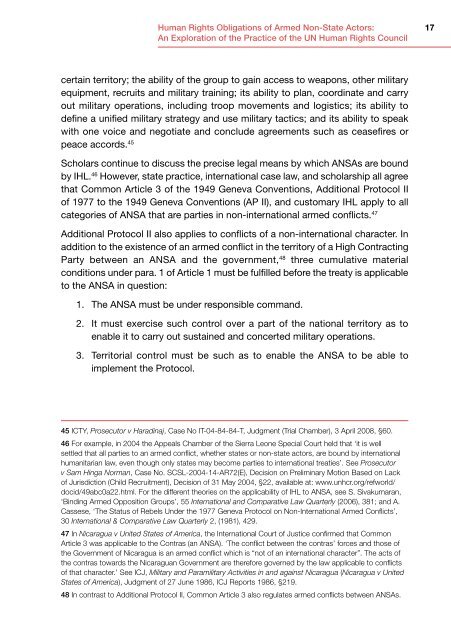InBrief7_web
InBrief7_web
InBrief7_web
Create successful ePaper yourself
Turn your PDF publications into a flip-book with our unique Google optimized e-Paper software.
Human Rights Obligations of Armed Non-State Actors:<br />
An Exploration of the Practice of the UN Human Rights Council<br />
17<br />
certain territory; the ability of the group to gain access to weapons, other military<br />
equipment, recruits and military training; its ability to plan, coordinate and carry<br />
out military operations, including troop movements and logistics; its ability to<br />
define a unified military strategy and use military tactics; and its ability to speak<br />
with one voice and negotiate and conclude agreements such as ceasefires or<br />
peace accords. 45<br />
Scholars continue to discuss the precise legal means by which ANSAs are bound<br />
by IHL. 46 However, state practice, international case law, and scholarship all agree<br />
that Common Article 3 of the 1949 Geneva Conventions, Additional Protocol II<br />
of 1977 to the 1949 Geneva Conventions (AP II), and customary IHL apply to all<br />
categories of ANSA that are parties in non-international armed conflicts. 47<br />
Additional Protocol II also applies to conflicts of a non-international character. In<br />
addition to the existence of an armed conflict in the territory of a High Contracting<br />
Party between an ANSA and the government, 48 three cumulative material<br />
conditions under para. 1 of Article 1 must be fulfilled before the treaty is applicable<br />
to the ANSA in question:<br />
1. The ANSA must be under responsible command.<br />
2. It must exercise such control over a part of the national territory as to<br />
enable it to carry out sustained and concerted military operations.<br />
3. Territorial control must be such as to enable the ANSA to be able to<br />
implement the Protocol.<br />
45 ICTY, Prosecutor v Haradinaj, Case No IT-04-84-84-T, Judgment (Trial Chamber), 3 April 2008, §60.<br />
46 For example, in 2004 the Appeals Chamber of the Sierra Leone Special Court held that ‘it is well<br />
settled that all parties to an armed conflict, whether states or non-state actors, are bound by international<br />
humanitarian law, even though only states may become parties to international treaties’. See Prosecutor<br />
v Sam Hinga Norman, Case No. SCSL-2004-14-AR72(E), Decision on Preliminary Motion Based on Lack<br />
of Jurisdiction (Child Recruitment), Decision of 31 May 2004, §22, available at: www.unhcr.org/refworld/<br />
docid/49abc0a22.html. For the different theories on the applicability of IHL to ANSA, see S. Sivakumaran,<br />
‘Binding Armed Opposition Groups’, 55 International and Comparative Law Quarterly (2006), 381; and A.<br />
Cassese, ‘The Status of Rebels Under the 1977 Geneva Protocol on Non-International Armed Conflicts’,<br />
30 International & Comparative Law Quarterly 2, (1981), 429.<br />
47 In Nicaragua v United States of America, the International Court of Justice confirmed that Common<br />
Article 3 was applicable to the Contras (an ANSA). ‘The conflict between the contras’ forces and those of<br />
the Government of Nicaragua is an armed conflict which is “not of an international character”. The acts of<br />
the contras towards the Nicaraguan Government are therefore governed by the law applicable to conflicts<br />
of that character.’ See ICJ, Military and Paramilitary Activities in and against Nicaragua (Nicaragua v United<br />
States of America), Judgment of 27 June 1986, ICJ Reports 1986, §219.<br />
48 In contrast to Additional Protocol II, Common Article 3 also regulates armed conflicts between ANSAs.


